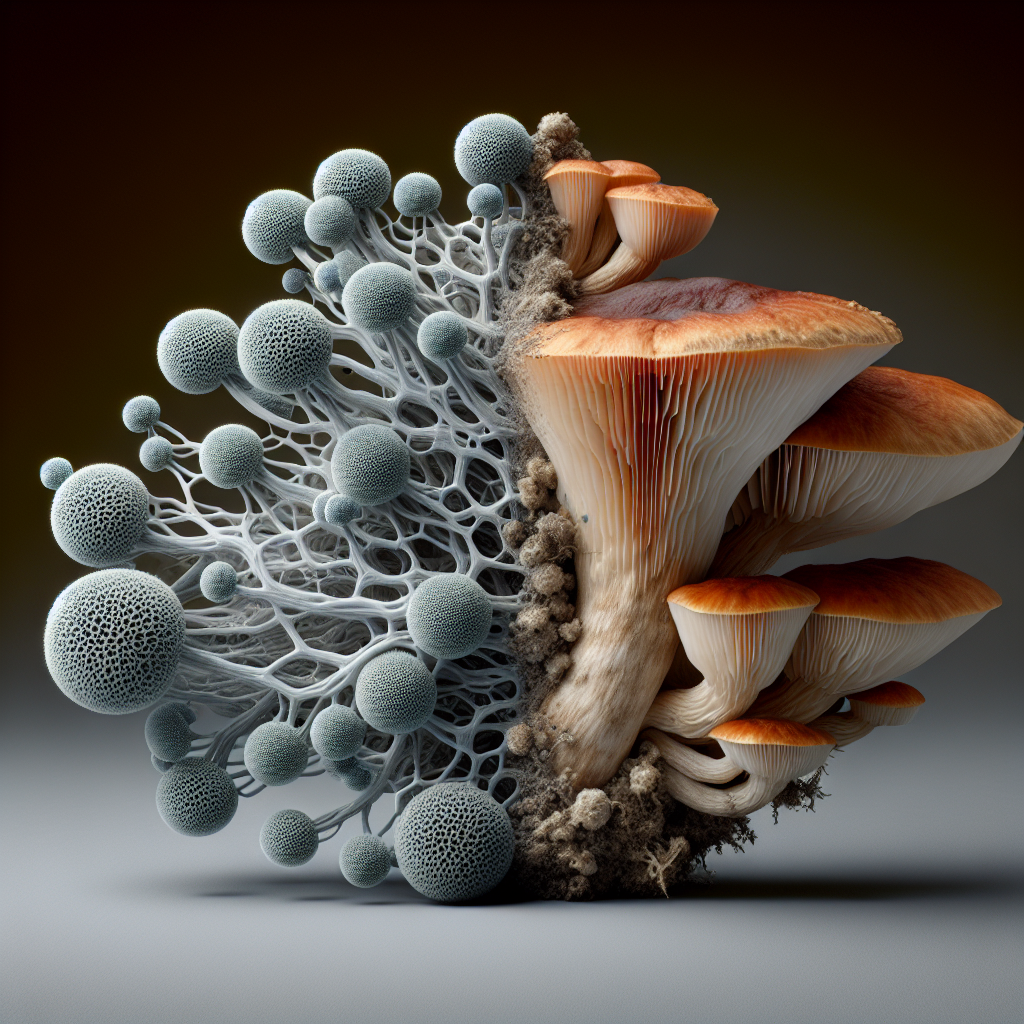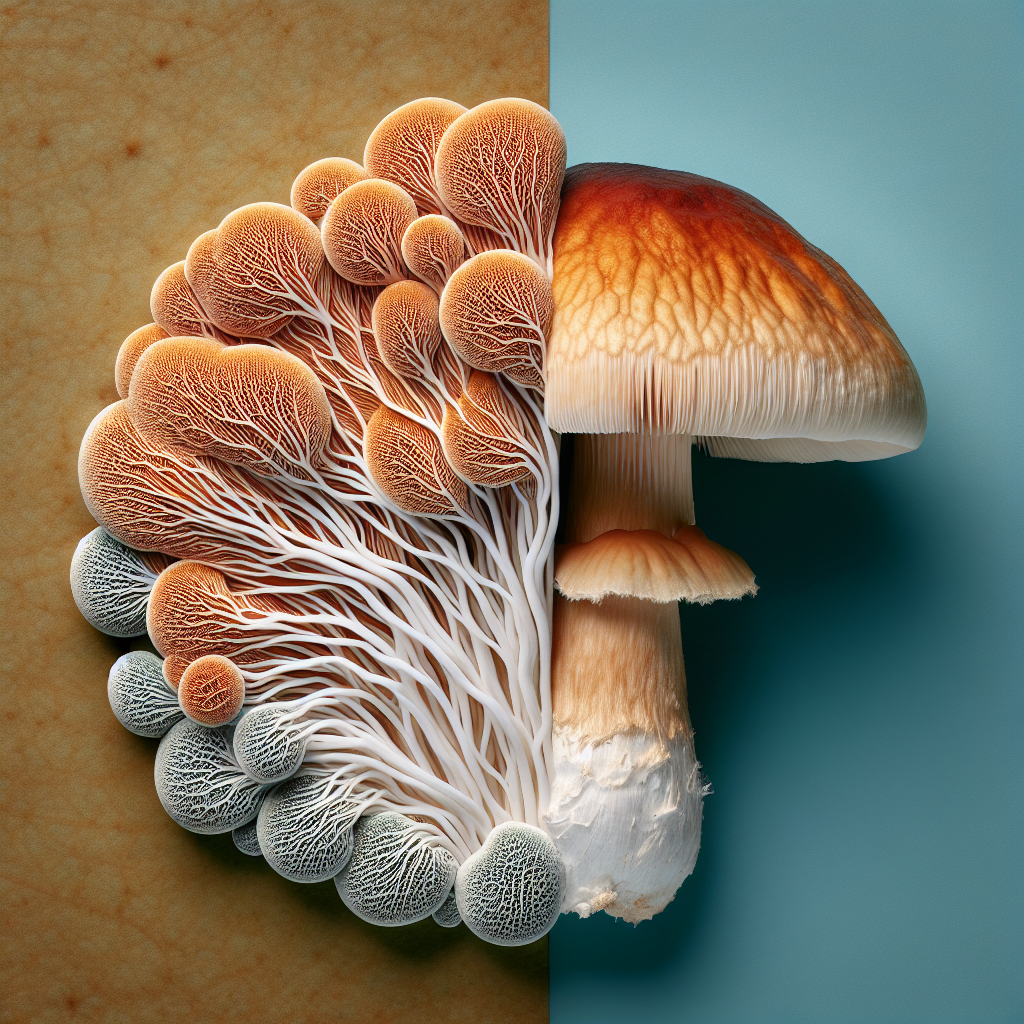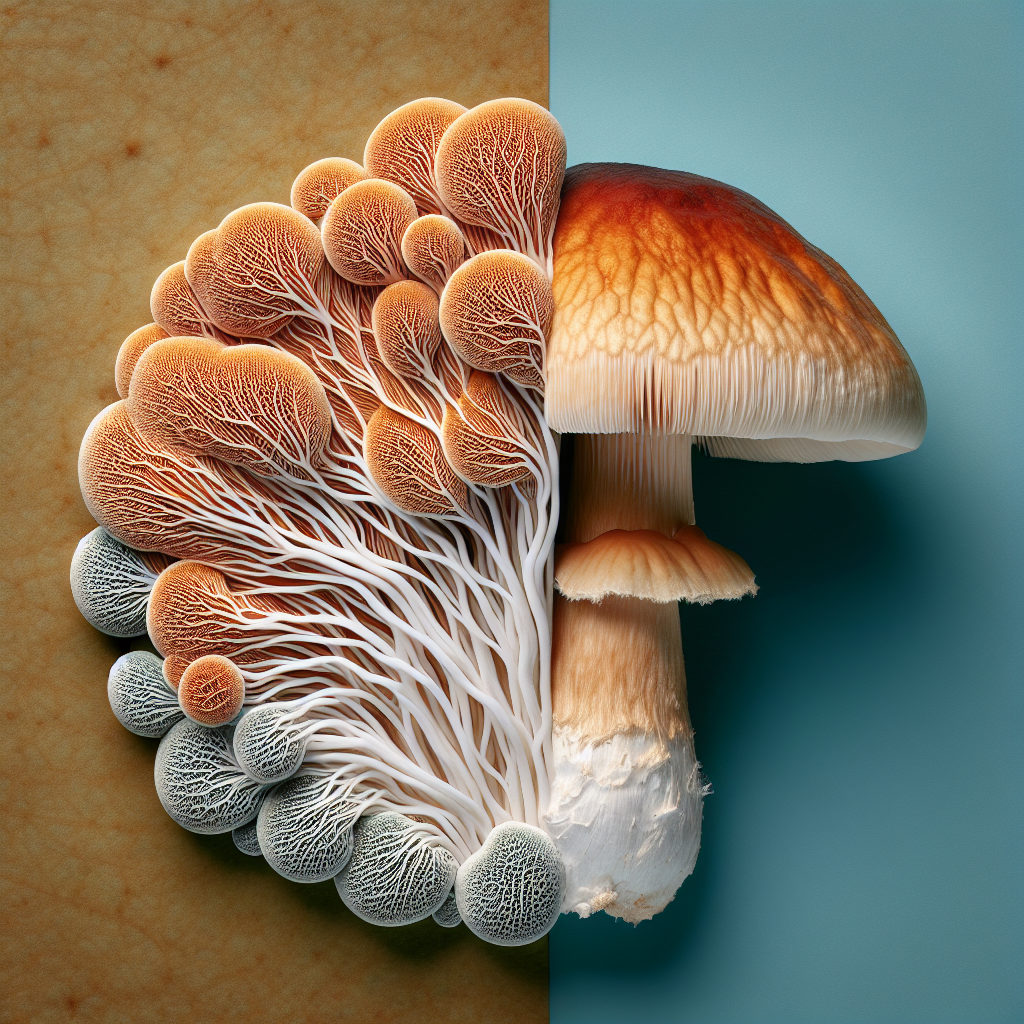In the fascinating world of fungi, intricacies often go unnoticed. Among these, a notable distinction lies between mushrooms and mycelium, two key components that differ remarkably despite their common origin as part of fungal life. “Understanding the Differences: Mushroom vs Mycelium”, aims to illuminate these disparities, showcasing the structural, functional and ecological contrasts that these two elements embody. Drawn from comprehensive research, this article simplifies intricate scientific concepts for you to appreciate and grasp the complex dynamics of the fungal kingdom.

Defining Mushrooms
Explanation of what mushrooms are
Mushrooms are fleshy, spore-bearing fruits of a fungus. They typically grow above the ground on soil or on their food source. With a myriad of species present, mushrooms can be small as a pinhead or grow to be several feet wide. While mushrooms represent only a small part of the fungus, they play a key role in the propagation of fungal species by releasing spores that lead to the formation of new fungal growths.
Brief history of mushroom use
Mushrooms have been used throughout history, for both culinary and medicinal purposes. Cultivation of mushrooms is believed to have begun in Asia, with evidence dating back to around 600 AD in China. Ancient civilizations like the Egyptians and Romans revered mushrooms, attributing them mystical powers. In modern times, the cultivation and consumption of mushrooms have spread worldwide, with mushrooms recognized for their nutritional and medicinal properties.
Types of mushrooms commonly found
There are countless species of mushrooms, each with their unique appearance, habitat, and properties. Some of the most commonly found types include button mushrooms, which are widely used in cooking, and shiitake mushrooms known for their health benefits. Other types include the reishi mushroom, prized in traditional medicine and the visually stunning, but deadly, Amanita muscaria otherwise known as the fly agaric.
Defining Mycelium
Explanation of what mycelium is
Mycelium is the vegetative part of a fungus, comprising a network of fine white filaments, or hyphae. While mushrooms are the fruition of fungal growth, mycelium represents the main body of the fungus. It is through the mycelium that the fungus absorbs nutrients from its surroundings.
Role of mycelium in the ecosystem
Mycelium plays an integral role in ecosystems, contributing to soil fertility and the decomposition of organic matter. Through their symbiotic relationship with plants, they aid in nutrient uptake, equating to plants’ overall robust health.
Structure and growth of mycelium
Mycelium exhibits a branched network structure, growing through the substrate or soil. As it grows, it penetrates organic material, decomposing and absorbing nutrients. The growth of mycelium is crucial to the survival and propagation of the fungus, as it provides the necessary nutrients for the formation of mushrooms.
Comparing Physical Features
Comparing size and shape
Comparing the physical features of mushrooms and mycelium, mushrooms vary greatly in size and shape, from tiny to gigantic, and from spherical to cylindrical or flat. Mycelium, being the vegetative part of the fungus, forms an extensive network of threads or hyphae, which collectively appear like a thin, white web spreading across the food source.
Discussion on their lifespan
The lifespan of mushrooms is relatively short, extending from a few days to a few weeks. Mycelium, on the other hand, can survive for years or even decades, growing and spreading steadily, benefiting from its ability to absorb nutrients directly from its environment.
Comparison of their growth conditions
Both mushrooms and mycelium prefer moist, dark conditions. However, while mushrooms can spring up anywhere there is adequate moisture and a food source, mycelium requires a more controlled environment, rich in organic matter, and with minimal disruptions to thrive.

Role in the Ecosystem
Role of mushrooms in the ecosystem
Mushrooms play a crucial role in the ecosystem, primarily in nutrient cycling. By decomposing organic matter, mushrooms contribute to the release of essential nutrients into the soil. Moreover, their spores aid in the propagation of the fungus, promoting biodiversity.
Role of mycelium in the ecosystem
Mycelium also plays an equally significant part in the ecosystem. Acting as nature’s decomposers, they break down dead plant and animal material, recycling nutrients back into the ecosystem. Additionally, they form symbiotic relationships with plants, aiding in nutrient and water absorption, thus contributing to overall plant health.
Interrelationship between mushrooms and mycelium in ecosystem
The interrelationship between mushrooms and mycelium in the ecosystem is vital for the survival of both. While mushrooms help in the propagation of the fungus, mycelium provides the nutrients required for the development of mushrooms. Thus, they indirectly contribute to each other’s existence while playing a key role in maintaining ecosystem stability.
Health Benefits
Health benefits of mushrooms
Mushrooms are rich in nutrients like vitamin D, selenium, and antioxidants. Regular consumption can aid in improving immunity, metabolic health, and may have anticancer properties. Empirical research suggests that mushrooms have a role in heart health, cognitive function, and gut health.
Health benefits of mycelium
Mycelium also offers significant health benefits. Its high fiber content can contribute to good gut health, while its rich nutrient profile can support immune function. Studies also suggest that mycelium may have potential therapeutic benefits against conditions like cancer and inflammation.
Comparative analysis of their nutritional content
While both mushrooms and mycelium offer significant health benefits, their nutritional profiles differ. Mushrooms typically contain higher levels of vitamin D and selenium, while mycelium is high in fiber and other nutritional bioactives. Regardless, both make valuable contributions to a balanced diet.
Culinary Uses
Common culinary uses of mushrooms
Mushrooms are a staple in many cuisines worldwide. They are used in a range of dishes, from soups and salads to main courses, due to their unique flavor and texture. In addition, dried mushrooms are used as seasonings or rehydrated for use in recipes.
Culinary uses of mycelium
While not as widely recognized in the kitchen as mushrooms, mycelium has numerous culinary uses. It can be used as a meat substitute due to its texture and ability to absorb flavors. There is ongoing innovation in exploiting this potential.
Distinct flavors and textures
When it comes to flavors and textures, mushrooms are quite diverse, ranging from earthy and nutty to woodsy and meaty depending on the variety. Mycelium, while not offering such a wide spectrum of flavors, is treasured for its unique, slightly sweet, and savory flavor along with a chewy texture.
Medicinal Uses
Traditional medicinal uses of mushrooms
Mushrooms have been used in traditional medicine for centuries for their therapeutic properties. They have been used to boost immune function, increase longevity, and even combat diseases like cancer. Reishi and shiitake mushrooms are well recognized for their medicinal potentials.
Potential medicinal uses of mycelium
Mycelium is also garnering attention for potential medicinal uses. Its strong nutritional profile suggests it may have immunomodulatory, antibacterial, and antiviral properties. Ongoing research continues to shed light on these and other potential medicinal benefits.
Recent studies on their medicinal properties
Recent studies indicate that both mushrooms and mycelium have substantial medicinal properties, with potential in treating various health conditions from inflammation to cancer. Though research is still in its early stages, the findings highlight the promising therapeutic potential of mushrooms and mycelium.
Industrial Uses
Wide range industrial uses of mushrooms
Mushrooms are used industrially in a wide array of applications from food production to the manufacturing of certain types of eco-friendly packaging materials. They have also found use in the textile industry, providing an alternative source of fabrics.
Innovative industrial uses of mycelium
Mycelium also offers myriad industrial applications. It’s being used in eco-construction for producing sustainable building materials, in the manufacture of bio-degradable plastics, and even generating biofuels.
Potential impact on sustainability
Considering their biodegradability and renewable nature, the industrial application of both mushrooms and mycelium holds significant potential for promoting sustainability. By displacing synthetic materials in various industries, they contribute to reducing environmental pollution and promoting a circular economy.
Cultivation and Harvesting
Cultivation methods for mushrooms
Mushroom cultivation involves the use of substrates, which provide the necessary nutrients for growth. These substrates can be logs, compost, or other organic material. The process involves several steps, including preparation and pasteurization of the substrate, inoculation with spores, and maintenance of optimal growth conditions.
Growing and sustaining mycelium
Mycelium cultivation is a more intricate process involving sterilized grains as a substrate, which are inoculated with spores under specific conditions to promote intensive mycelial growth. Once fully colonized, the substrate can then be used for various purposes.
Impact of environment on growth
Whether it’s mushroom or mycelium cultivation, both depend heavily on environmental factors. Temperature, humidity, and light conditions need to be accurately maintained for optimal growth. Inappropriate conditions may stunt growth or lead to diseases that can affect the entire crop.
Future Prospects and Research
Emerging innovations with mushrooms
There are ongoing innovations with mushrooms in various fields. This includes medicinal research, where the potential of mushrooms is being investigated in relation to conditions such as dementia and cancer. Important strides are also being made in exploring mushrooms as a sustainable material alternative in various industries.
Potential for mycelium in biotechnology
The potential of mycelium in biotechnology is immense. It offers a wealth of opportunities from the production of biofuels to the creation of medicinal compounds. It also holds promise as a potential source of environmentally friendly materials in several industrial applications.
Current trends in mushroom and mycelium research
Current trends in mushroom and mycelium research revolve around their diverse applications in culinary, medicinal, and industrial sectors. This includes research on the enhancement of the nutritional content of mushrooms, the therapeutic potentials of both mushrooms and mycelium, and their extensive industrial applications. With an increased focus on sustainability, the exploration of the potential of mushrooms and mycelium is an exciting field.
